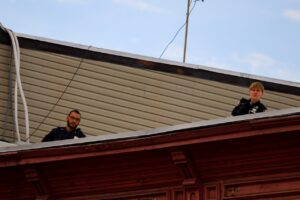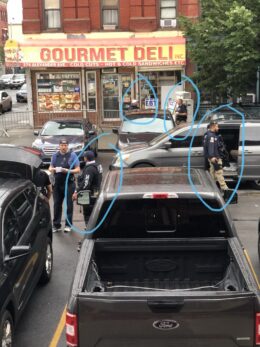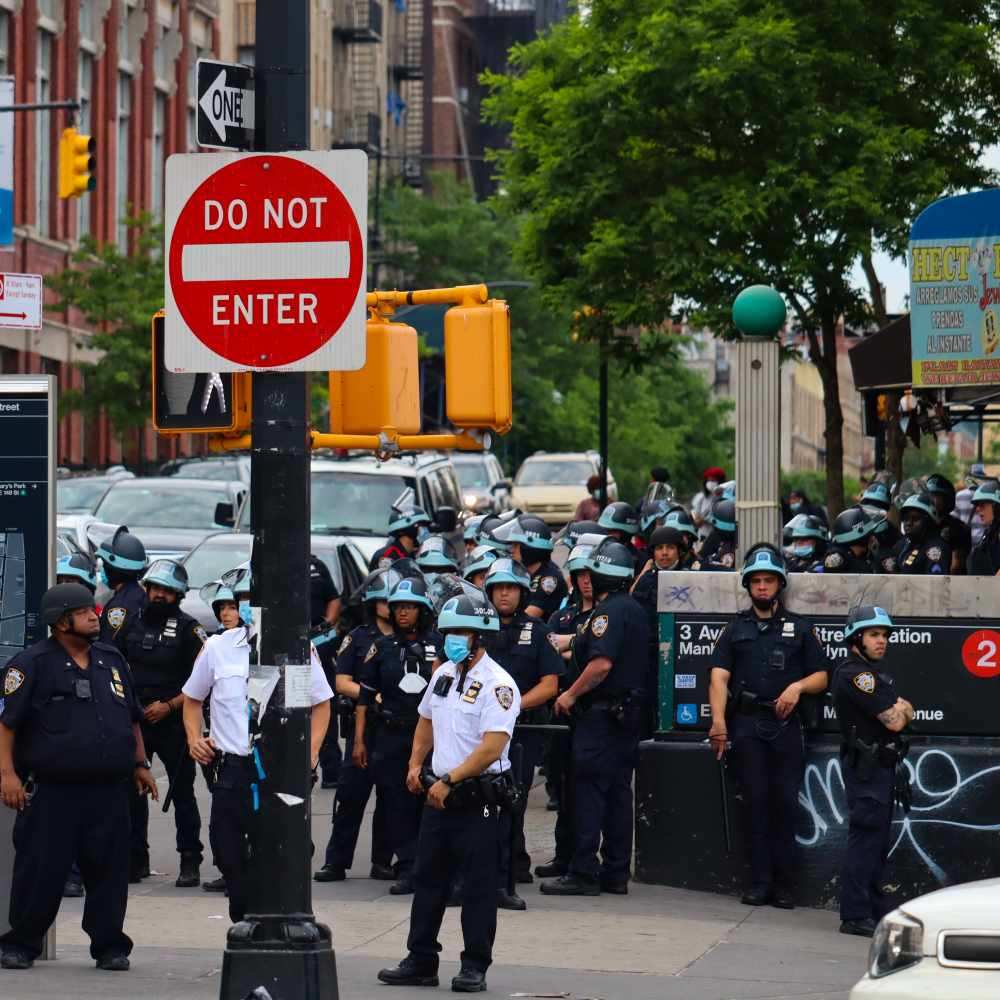Shellyne Rodriguez still feels the pain in her wrists from the zip ties. Justin McMillan remembers the puddle of blood he was forced to sit in for hours while his lungs burned from tear gas. Tanya Fields recalls the fear and anxiety she felt while seeking safety for her 17-year-old daughter.
The harrowing events of the evening of June 4 are etched in the minds of those South Bronx residents and hundreds of others who were demanding an end to police brutality only to be met with chemical sprays, fists and billy clubs at a protest in Mott Haven.
The protest was organized by grassroots groups Take Back the Bronx and Why Accountability NYC, to express solidarity with protesters nationwide who have called for defunding police, following the murder of George Floyd by a police officer in Minneapolis.
It came two days after Mayor Bill de Blasio declared an 8 p.m. curfew in response to looting of businesses around the city during protests in May.
Rodriguez, who has been with Take Back the Bronx since its origins a decade ago, said the group’s aim on June 4 was “to incite people to react, respond and self-determine. We saw Brooklyn and Manhattan, and we wanted to set the stage here.”
The unprecedented curfew, she said, “gave police full rein to terrorize this city.”
Around 7 p.m. some 300 protesters gathered at The Hub. Organizers brought helmets and goggles “because we had seen the violence perpetrated against protesters,” said Rodriguez.
Justin McMillan did not expect trouble. The former A.C.T.I.O.N activist at The Point CDC had attended a peaceful protest at Monsignor del Valle Square in front of the Hunts Point Avenue subway station the previous evening. The Hunts Point native had no reason to suspect the June 4 action would be different.
When McMillan and a friend arrived at The Hub, they assumed there would be time to make their way back home before the curfew kicked in. But as the march proceeded, the crowd became so thick, he said, that “there was nowhere to go.”

Though McMillan and other witnesses were spooked at the sight of officers on rooftops in The Hub, they continued on to East 138th Street along Willis Avenue, where they soon found themselves hemmed in by officers in front and behind, a tactic the police call “kettling.” McMillan wondered if the officers facing them on bicycles were really police. They wore riot gear but “no masks, no badges,” and “looked like they were from the military,” he said. There were medics as well, “making it seem like a war.”
McMillan said officers played chicken with protesters, starting to run toward them to sew fear, then stopping. Then, “as it got closer to 8, they started pepper spraying the crowd,” while “cutting off our routes of escape,” he said.
As his lungs burned with pepper spray, an officer cuffed him and pushed him down into a puddle of blood on the sidewalk. Three hours later he was taken to a Queens precinct and crammed into a cell with other protesters, where they shared animated dialogue about the protest and the nationwide convulsion after Floyd’s death.
When he was released at 3 a.m. and his jailers returned his camera, he found that several videos he had taken of the protest had been deleted.
Tanya Denise Fields, an old hand at protests, came with her 17-year-old daughter, carrying snacks and water for her fellow dissenters. The founder and executive director of the BlackFeministProject, Fields was aware of the risk.
Who were those unmasked men?
On June 13, Nine days after law enforcement cracked down on protesters on East 138th Street, some 30 Mott Haven residents marched in front of the Alexander Avenue station house to protest police behavior. NYPD did not intervene.
One protester, Monxo Lopez, says he was moved to protest a few weeks earlier when a throng of law enforcement gathered in front of his Alexander Avenue house two blocks north of the precinct during another street action by Mott Haven residents. Officers rushed up the stairs of his house, insisting they be given access to his rooftop as an observation post.
“It was like an order,” Lopez recalled, adding that none of the officers were wearing masks despite public advisories to do so, to help protect against Covid-19. “It reminded me of the kind of Argentinean, Brazilian dictatorship” tactics.“They were like mercenaries in the streets.”
Photos of that same spot on Alexander Avenue in front of his house on June 4 show men with Homeland Security Investigation (HSI) insignia on their jackets.

“We had seen the police (elsewhere) were already exhibiting patterns of brutalization,” she said, but added, “Never in my life had I experienced that. This was some 1966 Fascist shit.”
As law enforcement tried to “kettle folks” before they got to Brook Avenue, organizers advised the crowd through mic checks to stay calm and not to run.
“The ultimate objective was to arrest us,” Fields said. The officers were “full SWAT, looking like Ninja turtles behind their bikes, doing their creepy military thing, looking past you like you’re not there.”
Desperate to leave for the sake of her daughter’s safety, Fields told herself, “I know they’re going to escalate this.” Then officers in uniforms of varying colors that indicated they were not all NYPD, “start jumping on cars, hitting people—-it was insane, it was psycho. It was almost like they were foaming at the mouth.”
Fellow protesters came to her defense, “using their bodies to protect my child,” while officers beat them back, and pepper sprayed her. “You don’t know how terrifying it is to brace yourself when you’re about to be hit.”
Eventually she succeeded in pressuring police to let her and her daughter go.
“Fascist is the only word that resonates,” she summed up.
Although Mayor de Blasio and Police commissioner Dermot Shea have publicly denied accusations the NYPD planned to stamp out the Mott Haven protest, Fields says “I want to scream from the rooftops, ‘They lied.’ They had to lie to justify excessive force on women and kids.”
Some time after the officer had tightened the zip ties on Rodriguez’ wrists at the June 4 protest, three other officers tried to get the ties off her wrists, using pliers and other tools, recognizing that excessive force had been used on her. Medics on hand were screaming at police to loosen the ties, she said.
“I could see in their eyes they were panicking because they couldn’t get them off. I’m an artist. I need my fucking hands.”
Those zip ties served as “torture devices,” she said, to exact revenge on agitators like Take Back the Bronx and the protesters who marched with them, who she says were falsely accused of looting to justify excessive force.
“The Bronx political machine,” and some business leaders, “are really good at making us the villain,” she said.
Fields defers to the Movement for Black Lives’ mission statement calling for funds for police to be used instead for education, local restorative justice, employment programs and equitable universal health care.
“Police in this country were created to protect the interests of the state,” she said. “Until we can contend with that, there is no bridge” to be built with communities.
McMillan says the camaraderie he felt with other protesters has inspired him to continue calling for fundamental change.
“I never felt so connected with people,” he said.

